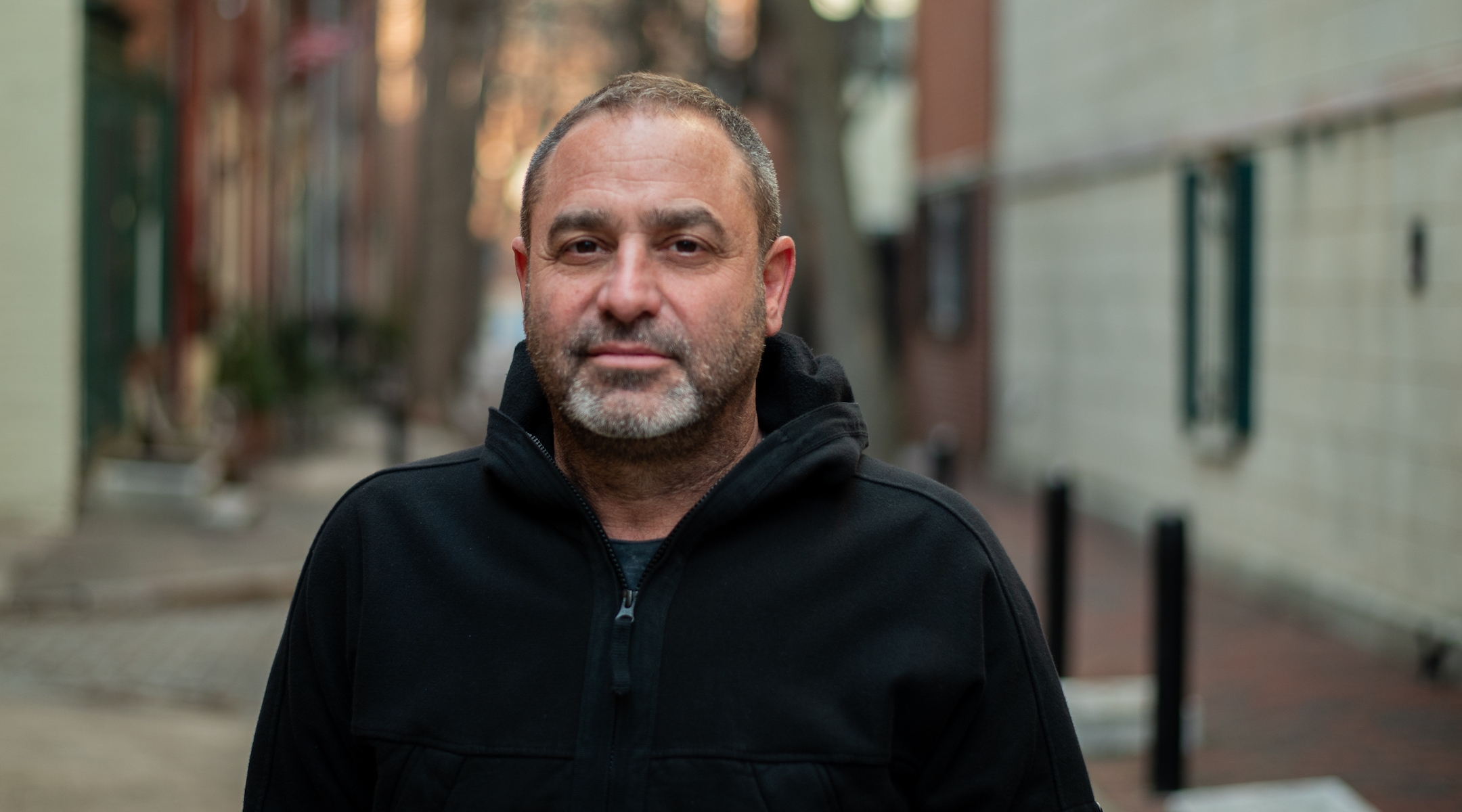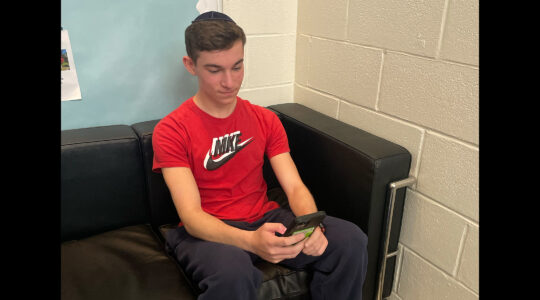(JTA) — A Jewish college student sits alone in a dark room watching a series of short videos. They are filmed altercations from the Israeli-Palestinian conflict, often violent, with some showing Israeli soldiers and citizens attacking or abusing Palestinian civilians. A camera trained on the student records her reactions as she watches. Occasionally a man, speaking on a microphone from another room, intervenes to ask her to clarify her thoughts.
This is the premise behind the documentary “The Viewing Booth,” a deceptively simple setup that becomes a complex meditation on how different audiences can interpret the same images of the Israeli-Palestinian conflict, and on whether filmmaking can truly be a tool for social change. The film’s Israeli director, Raanan Alexandrowicz (the man on the microphone), created the concept to better understand the impact of such images on audiences who may not agree with their contents.
What he found, Alexandrowicz said, caused him to question his own worldview.
Working from Temple University in Philadelphia, Alexandrowicz invited seven students to participate in the booth, filming them as they watched the footage in a technique calling to mind director Errol Morris’ “Interrotron.” Ultimately, though, “The Viewing Booth” focuses on only one participant: an undergraduate named Maia Levy, a last-minute addition during filming who identifies herself as strongly pro-Israel.
Levy is skeptical of much of the footage that Alexandrowicz shows her depicting Israelis in a negative light. Yet she’s drawn to it all the same.
“You should take all of these with a grain of salt,” she says while viewing footage distributed by the Israeli human rights organization B’Tselem. “There is 100% bias to this footage, but it’s still footage that I think still deserves some type of recognition.”
As Levy reflexively questions the content and motivations of the images, she and Alexandrowicz discuss the nature of truth and preconceived belief systems. The film climaxes with Levy returning to the booth, this time to watch the video of herself from the first session — a cinematic hall of mirrors.
Opening at New York’s Museum of the Moving Image on Friday after a two-year festival run, “The Viewing Booth” will also be available for free streaming on the BBC’s REEL website Aug. 18. Alexandrowicz is no stranger to uncomfortable interviews — his previous film was the acclaimed 2011 documentary “The Law in These Parts,” in which he interrogated the architects of the legal system that Israel imposed on the Palestinian territories it captured in the Six-Day War.
“I started [my career] by trying to document Palestinians for Israelis,” Alexandrowicz told the Jewish Telegraphic Agency. “And I’ve moved on from that. I feel it’s more important to represent to ourselves, as Jews, the mechanisms that we are constructing. If we are able to stare into them and understand them, we might want to disassociate ourselves from them.”
Ahead of his film’s release to the U.S. public, the filmmaker spoke to JTA about how he views “The Viewing Booth.” (This interview has been condensed and edited.)
JTA: How did you decide on the idea for the experiment, and what you were looking to learn from it as a filmmaker?
Alexandrowicz: “Experiment” is definitely the feel this film has, but I just want to make sure that it doesn’t come off as if I yielded some data. It’s a film that has the form of an experiment.
It’s a long journey that actually started five years earlier. I was questioning the effect of my previous work; I was also looking at the work of colleagues, specifically about this subject of Palestine and Israel, which I’ve devoted a few films to and is very important for me. And I asked myself, what is the role of documentation [when] trying to make change in the context of this historical event? Finally, what I came up with was that I need to try to understand what people get from the work that filmmakers, media makers, people who are making audiovisual documentation of any form, are doing.
I tried filming different viewers in different kinds of situations. I tried filming people in their natural situations at home. And I couldn’t find the right form. I decided to put out an open call at the university, asking people to come who are willing to be filmed while they’re watching these videos, and to verbalize their experience. I felt that something so constructed as asking people to watch and respond needed to be filmed in a way that would make visible its very constructedness.
In the film, you say that you put out an open call specifically for students who are interested in Israel.
Yeah, I would say that there was even more of a bias to it because I hoped I would find people who are very supportive of Israel. With earlier works, my primary audience was always Israeli. But in the U.S., I was very interested in Jewish audiences — and in Jewish audiences that were on the other side of the political map. That’s where I thought my work might have some sort of effect. So I published a call from the [Temple University] Hillel Facebook page, in the Jewish studies department, in places where there would be people who were very pro-Israel.
I’m often asked, “Why is this film only about Maia Levy and not about the other students who participated?” The reason I decided to make the film only about her is that she was most invested. These images were important to her as much as they’re important to me, although in a very different way. While hearing her responses, I understood that she is really an ideal viewer for myself as a filmmaker because on one hand, she’s very different from me politically. But on the other hand, she was a very open-minded, curious and authentic viewer.
I did try to edit sequences of a number of viewers watching certain videos while highlighting the differences between them. If [a participant] had the experience, for instance, of, while being Jewish, also being perceived as a brown person in the U.S., their experience of watching, for instance, that video of the home search [a B’Tselem-distributed clip of the Israeli military conducting a home search of a Palestinian family’s residence in Hebron] was different than the experience of Maia because they’ve had some previous experiences with police in the U.S.
After a few weeks I went back and looked at all of the footage that I had from Maia. There were about 100 minutes from that first session, and I felt that there was the heart of a more interesting film than the one I had intended. And that was when I started to think of inviting her back.
Maia is an American Jew; you’re an Israeli filmmaker. Do you intend for her to stand in for a broader American Jewish response? If not, what do you see her viewing experiences as representing?
That’s really important that you mentioned that because the one thing that I don’t want is to come off as if I’m trying to give some sort of an objective statement. It’s more of a case study of a conversation between one viewer, a set of images, and a filmmaker. So Maia doesn’t represent the group of people who answered the call. She definitely doesn’t represent American Jews. She represents one American Jewish viewer who I, as a filmmaker, would have wanted to understand something from the media that I make — which is not the media in the film.

Raanan Alexandrowicz is the director of “The Viewing Booth.” (Zachary Reese)
In the film, we see that Maia’s responses are causing you to question your own role as a documentary filmmaker. Can you break down that conversation? What was going through your head?
It made me question what it means to document the world now, or specifically to document Palestine and Israel and all the injustice that I see there, and all the things that have to change there.
It’s a film about miscommunication, of noncommunication. But in a strange way it becomes a dialogue of the different ways in which we look at images.
So, for example, we are looking at a video of this home invasion. So [the Israeli army is] coming into a home in [the West Bank city of] Hebron in the middle of the night, waking up the children and the family, conducting a search. Maia looks at it and sees it in a certain way. I look at it and see it in a different way. Now what I wanted, what I would have wished Maia as a viewer to do, was to take this image of the home invasion and read it through the context of 50 years of the military regime in the West Bank in which every night in those 50 years, homes are invaded, children are woken up — from minute one of the occupation until now.
And I would have wanted her to zoom out, to use a cinematic metaphor, and ask herself: What does this image mean if, in these last 50 years, every night you have so many of these? What she wants to do, and I’ll use another metaphor from cinema: She wants to pull the dolly back, to see the father holding a camera and filming the whole situation, filming his children being woken up.
At one point she asks, “What if there was a complaint about a bomb?” And there I do push back a little bit. I say, “Where did you get that context from?” She realizes that she’s actually taking this context from things she saw on “Fauda,” a dramatic series on Netflix. And in that way, again, she introduces something we should be thinking about: the way that fiction and nonfiction images at the moment are in a certain kind of relationship. The boundary between them is becoming more and more blurred.
You completed this film in 2019. How do you feel now after the last few months of videos from the latest violence in Israel and Gaza circulating online and people reacting to them? Does that affect how you view your own film?
Well, it doesn’t because I feel that this cycle is just repetition. What is the difference between this and what happened before? I think the images are out there all the time, but they’re now getting a lot of attention. Maybe more people are seeing them than only the people who usually seek them out, so there are more responses, more dialogue — and that’s where what we see in the film fits in because it gives a language, or suggests a new language, for looking at arguments about images.
If anything, something that really changed the perspective of the film is COVID and the fact that we lived in viewing booths. It’s become our life.
You’re doing a joint Q&A with Maia in New York to promote the film. What is her response to the film, and what is your relationship like now?
We never had any conversations with each other outside of the film until the first time we presented together at (the Tel Aviv documentary film festival) Docaviv. And that was the first time that I had some idea about her background and her family’s background, and how they came to be in the U.S. And of course, I also discovered that the more I knew about her, the more that I had boxed her into some definitions that weren’t necessarily true.
Maia likes the film. I think she feels that the film is her, or at least a portrayal of her at that time — now a few years have passed. Some viewers completely decide not to listen to her, and in that way they apply their own defense mechanisms: “What does she know about anything? I don’t feel like she can teach me anything.” I’ve heard that from people who program human rights festivals. For me, it signals they just don’t want to deal with what she brings up.
But I think the wider response to the film is that of people who, while they think very differently from her, respect the way that she’s able to reflect, the way that she’s able to be authentic, the way that she’s able to present us with a mirror of ourselves. Whether our political views are similar to hers or different, we all view things in this way: We all bring our own biases to things we see. We all work with these types of defense mechanisms, trying to position what we see so it fits with our worldviews.
JTA has documented Jewish history in real-time for over a century. Keep our journalism strong by joining us in supporting independent, award-winning reporting.






